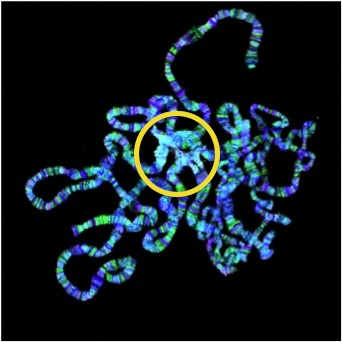H1 protein prevents genomic instability and hyperrecombination, which are typical in tumours. Scientists at the Barcelona Molecular Biology Institute (IBMB) of the CSIC and at the IRB Barcelona publish their results in Nature Communications.
 Scientists at the CSIC’s Barcelona Molecular Biology Institute (IBMB) and at the IRB Barcelona have identified a function, unknown until now, of the H1 protein. H1 is a histone, known for being a structural part of genome, but its function is, until now, a mystery.
Scientists at the CSIC’s Barcelona Molecular Biology Institute (IBMB) and at the IRB Barcelona have identified a function, unknown until now, of the H1 protein. H1 is a histone, known for being a structural part of genome, but its function is, until now, a mystery.
As scientists explain in the new study, H1 prevents genome instability. Its presence is essential for preventing and eliminating abnormal structures in heterochromatin, one of the most silenced and packed regions of the genome. The study, led by scientists Ferran Azorín and Jordi Bernués, it has been published in the last edition of Nature Communications.
H1 is crucial for life
The team led by Ferran Azorín has studied the role of H1 using Drosophila melanogaster fly, a usual laboratory model. The advantage of Drosophila is that it has only one form of H1, which facilitates the study –mammals have up to seven H1 isoforms.
Using genetic manipulation techniques, scientists obtained flies without H1 in the whole body. As a result, the flies couldn’t survive, which confirms that, whatever the function of H1 is, it is essential for life.
The next step was obtaining flies without H1 just in one organ (the wing). As a result, there were malformations and a general damage in the organ. Later, a cellular analysis unveiled a general cellular death (apoptosis) in the organ without H1.
Then, the scientists focused the study at cellular level. As scientists Ferran Azorín and Jordi Bernués explain, “depletion of H1 produces a severe genomic damage in the form of many DNA double-strand breaks, which generate genomic instability”.
And because there are so many breaks, scientists explain, the cells end up repairing the damage in the wrong way in the wrong places. “We wondered whether this was happening everywhere. The analysis demonstrated that the damage was not happening everywhere but especially in a region of the genome: the heterochromatin”.
Heterochromatin desilenced
Heterochromatin is the most packed and less rich in genes region in the genome. But it is also the most silenced: its genes and sequences are not expressed and, as a matter of fact, they are not expected to express. Heterochromatin has a structural role in the genome.
What scientists have seen is that the lack of H1 protein and the consequent damage is accompanied by the expression of heterochromatin sequences and retrotransposons.
“For the first time”, explains Bernués, “ we have seen that this damage is due to the formation of RNA-DNA hybrids, the called R-loops: structures formed when a newly synthesized RNA base-pairs with the transcribed DNA strand, leaving the other DNA strand, the non-transcribed one, loose”.
“Our results demonstrate that damage in the DNA, genomic instability and cellular death induced by the lack of H1, are directly related with these hybrid formation”, say the authors of the study.
Nevertheless, when scientists modified heterochromatin by other techniques, without eliminating H1, “the same genetic sequences were transcribed but there was neither damage nor R-loop formation because H1 protein was still there”, say scientists. “We think that H1 protein either must trigger a protective mechanism or it is an essential piece of this mechanism”.
The RNA:DNA hybrids appear naturally sometimes. But its uncontrolled formation, as it happens when H1 is missing, is a cause of strong genomic instability and it is, actually, a typical marker of tumours. As a matter of fact, some studies have demonstrated that H1 is reduced in some tumour cell lines.
Although this is a preliminary research, the study can give new clues about the mechanisms involved in genomic instability and hyperrecombination in some type of cancers.
Reference article:
Aleix Bayona-Feliu, Anna Casas-Lamesa, Oscar Reina, Jordi Bernués and Fernando Azorín. Linker histone H1 prevents R-loop accumulation and genome instability in heterochromatin. Nature Communications (2017) doi: 10.1038/s41467-017-00338-5
